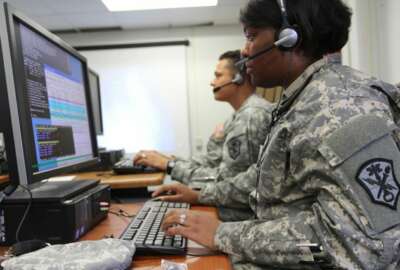DISA expects migrations to DoDNet to pick up steam in 2024
Carissa Landymore, the DoDNet program manager for DISA, said many of the defense agencies are completing the initial discovery phase to move to the DoDNet.
SAN DIEGO — The Defense Information Systems Agency has polished off many of the rough edges of its network consolidation effort called DoDNet.
Two years after making the $11 billion contract award under the Defense Enclave Services initiative, DISA is preparing to expand the number of users and capabilities DoDNet provides.
Carissa Landymore, the DoDNet program manager for DISA, said over the next year, the service provider will migrate more defense agencies to the platform and it will launch generation two with new capabilities.

“One of the things we’re trying to do with our generation two evolution, if you will, is really be able to posture ourselves to onboard those defense agencies and field activities (DAFAS) faster, more seamlessly and efficiently,” Landymore said in an interview with Federal News Network at the AFCEA West conference on Tuesday. “What that means is looking at the overall migration and seeing how we can deploy things or migrate these users in a multi-phased approach. Phase one could potentially be focusing on those endpoints, can we look at leveraging some of the cloud tools that are out there today, such as virtual desktop-as-a-service, and be able to migrate those users endpoints first, while in parallel, also working on the network migration.”
The network migration to DoDNet can be more complicated and take longer than the end point so splitting them into two phases, DISA says, can move customers through the process faster so they start seeing benefits.
DISA testing DoDNet first
Through the DES initiative, DISA is consolidating 600 separate contracts used to maintain the networks across 850 worksites across 22 different Fourth Estate agencies. DISA awarded the $11.5 billion DES contract to Leidos in 2022.
Landymore said DISA launched an internal pilot last year through DoDNet with VDIaaS and the success and lessons will help it offer that capability to others in DoD.
“Our goal is to have that ready to declare initial operating capability (IOC) by the end of May and be ready to deploy out to the DAFAs. We know the Defense Logistics Agency, in particular, is a big user of a VDI capability. So we want to make sure we are proud to support them,” she said. “I think that there’s also some opportunities from a costing perspective that we’re looking into. We’re doing the analysis right now, but we do believe that there’s going to be some opportunities there. One of the use cases that we’re seeing right now at DISA is looking at our contractor users where they won’t need government furnished equipment, but could use their contractor laptop, plug in a common access card (CAC) reader and then they’ll be able to log in via the VDI and be right in the DoD network. We are improving the user experience by having one laptop and being able to use it anywhere, anytime.”
Landymore said she expects several of the larger defense agencies to move out of the planning stage and into the implementation stage in 2024 and 2025, including DLA, the Defense Contract Audit Agency, the Defense Contract Management Agency, the Defense Media Activity and the Defense Threat Reduction Agency.
“Most of the organizations will wrap up their virtual discovery and physical discovery, and move right into the design and planning. A lot of these organizations have a lot of different buildings that have to be migrated so doing that virtual discovery and getting a snapshot into their existing footprint and coming up with our migration plan is where we are today,” she said. “Generation two will be huge because as we look across what’s to come next year and the year after, it’s the scalability that we’re bringing in and the additional capabilities will be able to posture us to be able to handle that additional workload. That’s really what Gen2 will provide us.”
DoDNet focused on common IT
DoDNet currently supports about 30,000 users from DISA, the Defense POW/MIA Accounting Agency and the Defense Technical Information Center on the unclassified and classified sides.
“When we think about the common IT, that’s really what we’re focused on right down to the end point, all of the cables behind the scenes. Some of the organizations that we’re supporting as well are also looking for management of their conference rooms as well. We’re also looking to expand that into wireless,” Landymore said. “Anytime any of those DAFAs have an issue or need any support, we also have our global service desk or tier one support. Those folks can put in their tickets routed through there, and then we handle all of that back end support as well down to the endpoint.”
One of the big benefits of moving to DoDNet, Landymore said, is for the defense agencies to address technical debt. She said all the planning and discovery work is helping to identify both legacy technology but potential funds the can use to upgrade their infrastructure.
From a cost savings perspective, DISA currently is working with DoD cost estimators to better understand those tradeoffs when moving to DoDNet.
Landymore said DISA believes migrating to the new platform will bring customers more automation, reduced labor costs and improved processes. Additionally, these defense agencies will reduce the amount of hardware they have to maintain by moving their infrastructure into the shared DISA cloud instance.
“We are hopeful that you’re going to see those tradeoffs here very soon. The team is doing that analysis now, and hopes to be able to present what those tradeoffs are and where we can see a reduction in the rate,” she said. “We don’t have the answers quite finalized. But that’s the thinking behind it. And hopefully, we’ll have some good news to share in the near future.”
Copyright © 2024 Federal News Network. All rights reserved. This website is not intended for users located within the European Economic Area.
Jason Miller is executive editor of Federal News Network and directs news coverage on the people, policy and programs of the federal government.
Follow @jmillerWFED







